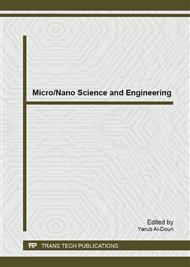[1]
M. Irie, Photochromism: memories and switches – introduction, Chem. Rev. 100 (2000) 1683-1684.
Google Scholar
[2]
A. Pościk, B. Wandelt, Application of a photochromic dye in an automatic welding filter, Int. J. Occup. Saf. Ergon. 15 (2009) 243-54.
DOI: 10.1080/10803548.2009.11076805
Google Scholar
[3]
R.M. Tarkka, M.E. Talbot, D.J. Brady, G.B. Schuster, Holographic storage in a near-ir sensitive photochromic dye, Opt. Commun. 109 (1994) 54-58.
DOI: 10.1016/0030-4018(94)90737-4
Google Scholar
[4]
S.S. Xue, G. Manivannan, R.A. Lessard, Holographic and spectroscopic characterization of spiropyran doped poly(methyl methacrylate) films, Thin Solid Films 253 (1994) 228-232.
DOI: 10.1016/0040-6090(94)90325-5
Google Scholar
[5]
N. Shao, J.Y. Jin, H. Wang, Y. Zhang, R.H. Yang, W.H. Chan, Tunable photochromism of spirobenzopyran via selective metal ion coordination: an efficient visual and ratioing fluorescent probe for divalent copper ion, Anal. Chem. 80 (2008) 3466-3475.
DOI: 10.1021/ac800072y
Google Scholar
[6]
S. Yagi, S. Nakamura, D. Watanabe, H. Nakazumi, Colorimetric sensing of metal ions by bis(spiropyran) podands: towards naked-eye detection of alkaline earth metal ions, Dyes Pigm. 80 (2009) 98-105.
DOI: 10.1016/j.dyepig.2008.05.012
Google Scholar
[7]
P.J. Coelho, L.M. Carvalho, L.F.F.F. Gonçalves, C.J.R. Silva, A.M. Campos, M.J. Gomes, Photochromic hybrid sol-gel films containing naphthopyrans, J. Sol-Gel Sci. Technol. 56 (2010) 203-211.
DOI: 10.1007/s10971-010-2295-5
Google Scholar
[8]
G. Schulze, K.J. Franke, J. I Pascual, Induction of a photostationary ring-opening-ring-closing state of spiropyran monolayers on the semimetallic Bi(110) surface, Phys. Rev. Lett. 109 (2012) 026102.
DOI: 10.1103/physrevlett.109.026102
Google Scholar
[9]
N.P. Ernsting, B. Dick, T. Arthen-Engeland, The primary photochemical reaction step of unsubstituted indolino-spiropyrans, Pure Appl. Chem. 62 (1990) 1483-1488.
DOI: 10.1351/pac199062081483
Google Scholar
[10]
T. Satoh, K. Sumaru, T. Takagi, K. Takai, T. Kanamori, Isomerization of spirobenzopyrans bearing electron-donating and electron-withdrawing groups in acidic aqueous solutions, Phys. Chem. Chem. Phys. 13 (2011) 7322-7329.
DOI: 10.1039/c0cp01989e
Google Scholar
[11]
Y. Atassi, J.A. Delaire, K. Nakatani, Coupling between photochromism and second-harmonic generation in spiropyran- and spirooxazine-doped polymer films, J. Phys. Chem. B 99 (1995) 16320-16326.
DOI: 10.1021/j100044a019
Google Scholar
[12]
R. Guglielmetti, 4n+2 systems: spiropyrans, in: H. Dürr, H. Bouas-Laurent (Eds. ), Photochromoism: Molecules and Systems (revised edn), Elsevier, Amsterdam, 2003, pp.314-466.
DOI: 10.1016/b978-044451322-9/50012-9
Google Scholar
[13]
D.J. McGarvey, Industry-linked context-based chemistry practicals, New Directions (2006) 57-64.
Google Scholar
[14]
Y. Sheng, J. Leszczynski, A.A. Garcia, R. Rosario, D. Gust, J. Springer, Comprehensive theoretical study of the conversion reactions of spiropyrans: substituent and solvent effects, J. Phys. Chem. B 108 (2004) 16233-16243.
DOI: 10.1021/jp0488867
Google Scholar
[15]
S.R. Keum, K.B. Lee, P.M. Kazmaier, E. Buncel, A novel method for measurement of the merocyanine-spiropyran interconversion in non-activated 1, 3, 3-trimethylspiro-(2H-l-benzopyran-2, 2'-indoline) derivatives, Tetrahedron Lett. 35 (1994).
DOI: 10.1016/s0040-4039(00)79953-9
Google Scholar
[16]
V.A. Barachevsky, Photofluorochromic spirocompounds and their application, J. Fluoresc. 10 (2000) 185-191.
Google Scholar
[17]
R.M. Negri, H.E. Prypsztejn, An experiment on photochromism and kinetics for the undergraduate laboratory, J. Chem. Ed. 78 (2001) 645-648.
DOI: 10.1021/ed078p645
Google Scholar
[18]
K. Shen, J.H. Kim, G.W. Kim, M.J. Cho, S.K. Lee, D.H. Choi, Photochromic behavior and its stability of a new bifunctional dye composed of spirobenzopyran and a cinnamoyl moiety, Macromol. Res. 13 (2005) 180-186.
DOI: 10.1007/bf03219050
Google Scholar
[19]
B.H. Lee, J.H. Kim, M.J. Cho, S.H. Lee, D.H. Choi, Photochromic behavior of spiropyran in the photoreactive polymer containing chalcone moieties, Dyes Pigm. 61 (2004) 235-242.
DOI: 10.1016/j.dyepig.2003.10.013
Google Scholar


